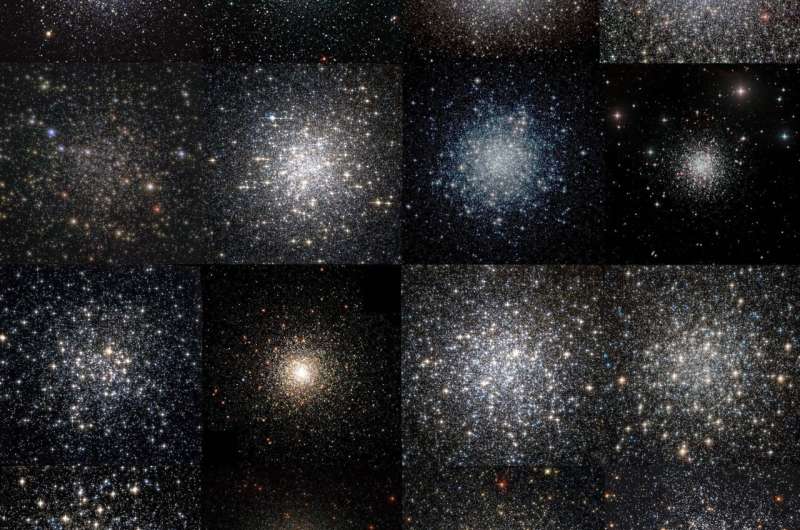
November 5, 2024 by Istituto Nazionale di Astrofisica
Collected at: https://phys.org/news/2024-11-3d-view-formation-evolution-globular.html
A study published in Astronomy & Astrophysics marks a significant milestone in our understanding of the formation and dynamical evolution of multiple stellar populations in globular clusters (spherical and very compact stellar agglomerates typically populated by 1–2 million stars).
This pioneering study, conducted by a group of researchers from the National Institute for Astrophysics (INAF), the University of Bologna, and Indiana University, is the first to perform a 3D kinematic analysis of multiple stellar populations for a representative sample of 16 globular clusters in our galaxy. It provides a groundbreaking observational description of their kinematic properties (i.e., how stars move within globular clusters) and their long-term evolution from formation to the present day.
Emanuele Dalessandro, researcher at INAF in Bologna, lead author of the article and coordinator of the working group, explains, “Understanding the physical processes behind the formation and early evolution of globular clusters is one of the most fascinating and debated astrophysical questions of the past 20–25 years.
“The results of our study provide the first solid evidence that globular clusters formed through multiple star formation events and place fundamental constraints on the dynamical path followed by the clusters throughout their evolution. These results were made possible by a multi-diagnostic approach and the combination of state-of-the-art observations and dynamic simulations.”
The study highlights that the kinematic differences between multiple populations are key to understanding the formation and evolution mechanisms of these ancient structures.
With ages that can reach 12–13 billion years (thus dating back to the dawn of the cosmos), globular clusters are among the first systems to form in the universe. They represent a typical population of all galaxies. They are compact systems (with masses of several hundred thousand solar masses and sizes of a few parsecs), and they can be observed even in distant galaxies.

“Their astrophysical significance is huge,” says Dalessandro, “because they not only help us to test cosmological models of the formation of the universe due to their age, but also provide natural laboratories for studying the formation, evolution, and chemical enrichment of galaxies.” Although globular clusters have been studied for over a century, recent observational results show that our knowledge is still largely incomplete.
“Results obtained in the last two decades have unexpectedly shown that globular clusters consist of more than one stellar population: a primordial one, with chemical properties similar to other stars in the galaxy, and another with anomalous chemical abundances of light elements such as helium, oxygen, sodium, and nitrogen,” says Mario Cadelano, researcher at the Department of Physics and Astronomy at the University of Bologna and INAF associate, one of the authors of the study.
“Despite the large number of observations and theoretical models aimed at characterizing these populations, the mechanisms regulating their formation are still not understood.”
The study is based on the measurement of 3D velocities, i.e., the combination of proper motions and radial velocities, obtained with the ESA Gaia telescope and with data from, among others, the ESO VLT telescope, primarily as part of the MIKiS survey (Multi Instrument Kinematic Survey), a spectroscopic survey specifically aimed at exploring the internal kinematics of globular clusters. The use of these telescopes, from space and the ground, has provided an unprecedented 3D view of the velocity distribution of stars in the selected globular clusters.
The analysis reveals that stars with different abundances of light elements are characterized by different kinematic properties, such as rotational velocities and orbital distributions.
“In this work, we analyzed in detail the motion of thousands of stars within each cluster,” adds Alessandro Della Croce, a Ph.D. student at INAF in Bologna. “It quickly became clear that stars belonging to different populations have distinct kinematic properties: stars with anomalous chemical composition tend to rotate faster than the others within the cluster and progressively spread from the central regions to the outer ones.”
The intensity of these kinematic differences depends on the dynamical age of globular clusters. “These results are consistent with the long-term dynamical evolution of stellar systems, in which stars with anomalous chemical abundances form more centrally concentrated and rotate more rapidly than the standard ones.
“This, in turn, suggests that globular clusters formed through multiple star formation episodes and provides an important piece of information in defining the physical processes and timescales underlying the formation and evolution of massive stellar clusters,” Dalessandro emphasizes.
This new 3D view of the motion of stars within globular clusters provides an unprecedented and fascinating framework for the formation and dynamical evolution of these intriguing systems. It also helps to clarify some of the most complex mysteries surrounding the origin of these ancient structures.
More information: E. Dalessandro et al, A 3D view of multiple populations’ kinematics in Galactic globular clusters, Astronomy & Astrophysics (2024). DOI: 10.1051/0004-6361/202451054
Journal information: Astronomy & Astrophysics

Leave a Reply